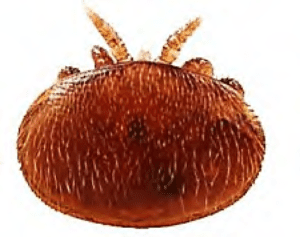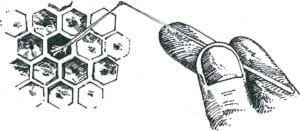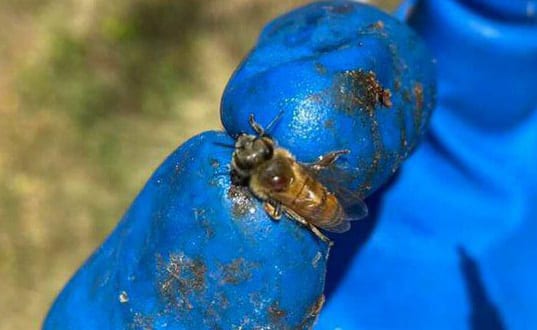The occurrence of diseases in honeybees depends upon three factors:
1. Bees (their genetics): the hygienic behavior and resistance to various diseases varies from colony to colony and it is based on the genetic heritage of the queen bees.
2. Pathogens (their presence, infectious load and virulence): the disease needs the presence of the responsible agent to manifest itself (a virus, bacteria, fungus or protozoa), but the pathogen’s quantity and ability to spread are also very important.
3. Environment (temperature, relative humidity, presence of nectar plants): environmental conditions and seasonal factors strongly influence the onset of diseases, in many cases they are real key triggers.
Further, the diseases of honeybees can be classified depending on:
- The nature of the agent responsible for the disease: parasitic, fungal, bacterial or viral infection
- The function of the individuals who are affected in the hive: brood diseases and diseases of adult bees.
While Barbados is fortunate that many of the more common bee pests and diseases are not found here, we need to be able to identify them and respond quickly to any potential outbreaks that may occur. The following pests and diseases are mainly responsible for transmitting disease within hives worldwide.
Varroa Mite
The varroa mite, Varroa destructor, is responsible for Varroatosis (or Varroosis), an external parasitic disease that attacks honeybee colonies (adult bees and especially the brood). It causes the principal economic losses to the beekeeping sector because it is widespread and has adapted significantly to the conventional treatments. This mite affects both the brood and the adult bees. It weakens the adult bees by suctioning off their hemolymph. The weakened bees are more susceptible to other diseases, especially viral pathologies. The first to suffer are the stronger colonies with more brood because of the higher possibility of the mite to replicate at the brood levels. In Barbados, the mite, having been the cause for the collapse of the main apiaries in Barbados in the 90s, has since been, to a large degree, under control. It is a mite that has evolved with the honey bee and for which the honey bee is its only host. It is therefore necessary to remain alert to its possible presence and take remedial action when necessary. It is estimated that mite counts with a ratio of greater than 10% relative to the amount of workers will impact the economic outputs of the hive. The parasite, at all developmental stages, feeds on the adult honey bee hemolymph for sustenance, leaving open wounds on the bees. The quantity of hemolymph ingested by the mites varies depending on the time of year. The compromised adult bees are more prone to infections. Varroa can live up to five days out of the hive if the environment favors its survival (temperature, humidity). The life of the varroa female is, on average, two months in Barbados.
Identification: The mite is a small, oval-shaped parasite that lives on the bee’s back. Mite levels can be checked by opening a sealed drone brood and looking for the brown mites on the white pupa.

Symptoms: In colonies contaminated by varroa, it is possible to observe:
- The parasites on the body of adult bee.
- A scattered brood pattern.
- A typical stench of dead brood.
- Smaller bees.
- Bees with deformed wings.
- Sick bees crawling in front of colony.
- Weakening of the colony as it becomes less populated and due to the reduced capacity of the bees in the collection and storage of supplies.
- Abnormal swarming (especially at the end of the season) and replacement of the queen.
- Clusters of bees restless and unable to fly.
Treatment: There are very few remedies for varroa as the mite has a strong adaptability to treatments. Traditionally beekeepers used Apistan® to treat for mites, but this is also toxic to the bees. An organic product, Aluén CAP®, was recently introduced in Argentina that has been proven to be 98% effective without causing any harm to the bees. In the region, there are reports of beekeepers using bay leaf to control the mites. The number of mites that naturally fall every day on the hive bottom board (or diagnostic board) is a good indicator for the infestation rate in the hive. For the purpose of counting the mites, it is important to keep the diagnostic bottom tray clean. Females of varroa are easily detectable on the diagnostic board, especially after anti-varroa treatments, as they provide a fair estimate of the actual level of infestation.
Chalkbrood
Chalkbrood is a fungal disease of honeybees that occurs worldwide. Chalkbrood is caused by Ascosphaera apis and affects the brood. Bee larvae become infected by ingesting spores of the Ascosphaera apis with its food. The spores germinate in their intestines, leading to the death of the larvae. Each dead larva of chalkbrood produces billions of spores and, if not removed by the worker bees, they can remain infectious for several years within the hive. Ascosphaera apis grows better in larvae situated more externally in the brood because it is colder. This phenomenon may occur especially during the colony spring growth, when the number of adult bees is not enough to allow an adequate nest temperature control to cover the whole brood area. Less populated and weaker colonies are more susceptible, as the bees are not able to keep all brood warm. Drone larvae are usually the most affected because of their location on the margins of the brood chamber.
Identification: Chalkbrood is identified by the gray “mummies” in front of hives or in brood nests. It is common in the rainy season when humidity is high.
Symptoms: The larvae may be affected in different life stages, more frequently on the third or fourth day of larval life. They then die in the first two days after capping, so bees must uncap the cells to remove the dead larvae. Chalkbrood produces a mummification and/or calcification of the larvae. Firstly, larvae appear soft, assuming the hexagonal shape of the cell, before drying out and becoming hard. The larger part of affected larvae appears white, but some become grey or black. They may not present any symptoms if the infection is less than 12%. The presence of little stones (chalkbrood) on the bottom or at the entrance of the hive is typical.

Treatment: Many drugs have been tested, but the persistence of spores makes the disease’s eradication impossible. The best solution seems to be the administration of sucrose syrup (1:1) acidified with lemon juice or vinegar or ascorbic acid powder until it reaches a pH of 4. Prevention is also possible with the application of good apiary management practices such as:
- The selection of appropriate locations;
- Elevating hives and keeping them in the sun,
- Selecting resistant queens and ensuring enough food reserves in the hive (also feeding artificially when necessary).
- Combining the affected hive with a stronger colony.
Small Hive Beetle (SHB):
The Small Hive Beetle (SHB), Aethina tumida, is a pest native to sub-Saharan Africa that affects the honey bee colonies and other pollinating insects of the Apoidea family, such as the bumble bees (genus Bombus). Today, the SHB is present throughout the Americas and the Caribbean, with evidence of it found most recently in Brazil in 2016. Beetles are attracted by the scent of live bees and combs containing pollen and/or larvae. Once inside the hives, the females begin to lay hundreds of eggs, preferably on the brood combs by drilling the cap of the brood or in the hive cracks. During their four to six months life cycle, they may lay more than a thousand eggs. At the end of their development, the mature larvae are concentrated at the bottom of the hive, and will leave the hive through the hive entrance, or any other opening in the hive and drop on the ground. Larvae then penetrate up to a depth of 5-10 cm into the soil (preferably sandy soil) to metamorphose. The period spent in the soil is usually 3-4 weeks (with variations from two to eight weeks, depending on the temperature and the soil properties). The SHB can spread very rapidly flying from apiary to apiary, but also through the trade of bee packages, artificial swarms, queen bees, raw wax and beekeeping materials. There have only been rare reported occurrences of SHB in Barbados.
Identification: The larvae of the SHB are cream-coloured and about 11 mm long at the end of their development stage. The larvae can be recognized by four rows of dorsal spines along the back, three pairs of legs and two rear spines. Adults of the SHB are oval-shaped. As they age, adults are first yellowish-red, then become gradually brown, dark brown and eventually black when they reach sexual maturity (Figure 3). They can survive inside the hive up to six months. The body is rather flattened, 5 – 7 mm long and 3 – 4.5 mm wide (about 1/3 of the adult bee size). The antennas are club-shaped and the (rather long) legs enable the SHB to move easily and quickly inside the hives.
Symptoms: Larvae cause enormous damage to the hives, digging tunnels among the cells of the honeycomb to feed on pollen, honey and bee brood. They defecate on honey and on the combs resulting in the combs becoming slimy and acquiring a characteristic smell of rotten oranges. In fact the excrements of larvae can cause honey alterations and fermentation, until honey becomes no longer suitable for human consumption. The fermented smell is a typical sign of infestation by the beetle. A high number of SHB larvae in the hives can totally destroy the combs and they may also cause the colony to swarm.
Treatment: There are many management practices that one may employ to treat outbreaks of the hive beetle. However, a combination of different control strategies (based on your situation) seems to be the best applicable solution. The first strategy should be to install mechanical traps or biological control methods and, only subsequently, chemical control methods (i.e. when the population of beetles threatens the survival of the colony). Regulations restricting the importation of bees are the main defense against the introduction of SHB in SHB-free countries. It is essential that all beekeepers adhere to this rule to ensure the effective prevention of the SHB introduction into SHB-free areas. Some of the management practices include:
- Keeping only strong colonies in the apiary
- Adopting traps to control and monitor the parasite inside the hives
- Achieving good hygiene practices during extraction and at the apiary level to prevent the spread of SHB.
American Foulbrood (AFB):
American Foulbrood (AFB) is a disease of honeybees caused by the spore-forming bacteria Paenibacillus larvae, that affects the brood. It is considered the most widespread and destructive bee disease, and it can cause serious economic losses to the beekeeping industry. The term “American” does not refer to the fact that the disease has been imported from the United States of America, rather because it has been studied and identified in this country. Bee larvae are the main target of P. larvae in their first 24 hours of life. The spores become active in the digestive tract of young larvae. After seven days of infection, the infected larvae die and the P. larvae turns back into the spore form, not finding the suitable conditions for development. The disease is spread easily, from colony to colony, by robbing and drifting bees. The spores remain viable, indefinitely, on beekeeping equipment. Fortunately, there have been no cases of AFB outbreaks in Barbados to date.
Identification: The AFB spores are microscopic and, thus, cannot be detected by the naked eye. However, the disease can be identified by the sunken and perforated brood cell capping. Another check for AFB can be made by sticking a toothpick into a sunken cell; if the dead larva pulled out has a ropey slime, this is indicative of the presence of AFB. In addition, the colony smells of something rotting, with hard, spore-bearing “scales” forming in advanced stages; and the honeycomb appears irregularly capped.

Symptoms: The onset of symptoms depends on the number of spores; there must be at least 50 million spores for the disease to appear in a bee colony. A bee larva that dies of AFB contains about three billion spores. For this reason, it is so difficult to eliminate and control the spread of AFB. The affected brood is characterized by high mortality.
Treatment: The best way to treat frames affected by AFB is to pull them out and burn them to avoid robber bees carrying the spores to other colonies. When a colony is badly affected, no cure will help. The entire hive box, with the colony, should then be burned and the hive and hive tools rinsed in 70% alcohol. Also, replace old black wax regularly as this harbors many chemicals and diseases.
European Foulbrood (EFB):
European Foulbrood (EFB) is a bacterial disease that affects the honey bee brood cause by the bacterium Melissococcus pluton, often associated with other bacterial agents including Bacillus alvei, Streptococcus faecalis, Achromobacter eurydice, Paenibacillus alvei and Bacillus laterosporus. The genetic resistance of some species of bees to this disease may, especially in favorable environmental conditions, allows them to overcome the infection without suffering serious damage. However, it should be noted that, even if characterized by a better prognosis than the American Foulbrood, in some areas the EFB has a more malignant manifestation, seriously damaging even very strong bee colonies. The bacterium develops inside the hive at the brood level. This disease is spread orally, inside the hive, by the nurse bees that, in an attempt to clean up the cells by the dead larvae, get contaminated with the spores before transmitting them to the brood when they go to feed it. Similar to AFB, the disease can be spread from hive to hive or apiary to apiary by the bees (especially when bees rob a diseased hive) and by the beekeeper (with the use of infected honey to feed healthy colonies, moving diseased colonies during migratory beekeeping, trade of infected tools, use of contaminated equipment, moving of combs from one hive to another, etc.). The health status of the colony is very important for the development of the disease inside the colony; weak colonies, or colonies that are stressed for any reason (food shortage, migratory beekeeping, pesticides, etc.), as well as colonies that are genetically more sensitive, are especially prone to this disease.
Healthy and strong colonies will be able to recover from the disease by themselves, if the season guarantees adequate food sources (pollen, nectars and flowers).
Identification: Similar to AFB, EFB cannot be detected by the naked eye. The uncapped larval stages of the brood, although discolored and twisted, do not have the ropey larva when applying the toothpick test. Unlike the American Foulbrood, M. pluton kills the larvae before the cells’ capping. The death of the larvae occurs with open cells, this being one of the features of EFB that renders it distinguishable from the AFB. Only in the case of serious infection, with EFB, can the larvae die in capped cells. Another distinguishing feature of this disease is that the affected larvae, instead of being horizontally positioned on one side in a C-shape and adhering to the back of the cells, often change position. The infected larvae initially lose their pearly white color to become first opaque, then yellowish and finally yellowish-brown. After death, the larva becomes darker and decomposes, turning into a soft brown mass which is neither viscous nor stringy, unlike the larvae infested with AFB.
Symptoms: The transmission of EFB from the adult bee to the larva takes place orally. After the infection, the larvae die in a few days (regardless of whether the larvae are working bees, drones or queens). The brood appears scattered, with cells containing yellowed dead larvae. Depending on the bacteria present, the dead larvae may give off smells of different intensity. The M. pluton leads to a sour smell, with flabby, but intact larvae; if, however, it is associated with Bacillus alvei, the brood has a putrid smell with molten larvae. There are also intermediate forms in which the combs give off no smell at all.
Treatment: EFB is not a spore-forming bacteria and, as such, the hive does not have to be burned. Hygienic bees will clean and remove EFB as the colony gets stronger. However, in the case of the disease reaching its advanced stage , weak colonies or low prevalence of the disease in the apiary, then destruction by incineration of the infected colonies is advised. If the outbreak is minor, then proper disinfection of the hive and all the tools should suffice. Likewise, it is possible to perform the “shook swarm method”, consisting of shaking the adult bees from the infected hives into a clean hive with a new foundation.
Wax Moth:
While many beekeepers consider the wax moth to be a pest, it actually has more of a symbiotic relationship with the honey bees; they provide a hygienic service by eating old wax combs. As was mentioned earlier, old wax often harbours disease-carrying agents and, therefore, by the wax moth removing this wax, it also cleans up the hive for the bees. Many natural beekeepers believe that wax moths shouldn’t be considered pests at all, given that they have evolved with bees to provide this sanitation service. However, while this is the case, we have to be careful as the wax moth could compound the threats posed to weak hives and lead to absconding. To avoid wax moths, beekeepers should keep hives strong and exposed to sunlight. If there has been an infestation of wax moths, it is suggested that the webs be removed and the hives soaked in a bleach solution to destroy any remaining eggs. Boxes should then be left in the sun to dry before restarting the hive. Avoid damp areas with poor air flows to limit the prevalence of the wax moth.
Ants & Frogs:
Both ants and frogs are common to Barbados. While they do not transmit any diseases to the bees, they have traditionally posed challenges to local beekeepers. Ants, as we know, love sugar and are, as such, lured to the hive by the scent of the honey. Strong, resilient hives are less susceptible to ant invasions, but with small vulnerable hives, the ants will come in search of the honey. The best way to impede ants entering the hive is to keep hives off the ground and coat the legs of the stands with axle grease or set the legs in cans of old cooking oil to prevent the ants from climbing. Likewise, spreading wood ashes around and under the base of the hives helps tremendously, as does keeping the ground cover around the hives low.
Frogs, on the other hand, feed on insects and bees are no exception. It is not uncommon in Barbados to see frogs at the entrance of beehives lapping up bees as they land at the entrance of their hives. This would have a direct impact on the colony’s population and therefore should be avoided. Similar to control of ants, it helps if the hives are raised at least 18” from the ground to prevent the frogs from reaching the hives’ landing board. Moreover, the prevention of hive predators can be achieved by ensuring that the grass around hive boxes is kept low.
There are other pests that constitute more of a nuisance than a threat. This category is mainly represented, in Barbados, by monkeys and “peewittlers”. Monkeys, being curious creatures by nature, may provoke or even topple hives. To safeguard against the toppling of hives by monkeys, one may secure the hives with straps or place a concrete block on them similarly to how you would to protect them from a storm. Peewittlers are a particularly annoying species of bird. They will knock on the hives and fly away, causing disturbance to the hives and keeping the soldier bees busy.
Adapted from “Barbados Beekeeping Guide, IICA Barbados Delegation, 2020”


Recent Comments